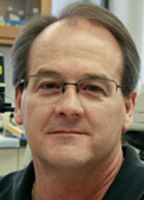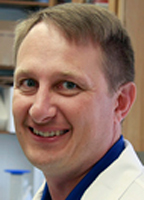 |
Geoff Thiele, Ph.D. |
Yet heart disease doesn’t kill everybody.
Understanding why has been a confounding riddle for modern medicine.
An team of researchers at UNMC believe they’ve made a potentially groundbreaking discovery — a test that determines whether a patient is harboring the dangerous type of heart disease that kills one in four Americans every year.
 |
Michael Duryee |
Geoff Thiele, Ph.D. a professor of internal medicine, and Michael Duryee, a research coordinator for the division of rheumatology and immunology, made the initial discovery. While looking for clues to help understand inflammatory conditions such as arthritis, they focused on a molecule that is a strong indicator of inflammation.
Known as MAA or malondialdehyde-acetaldehyde, the molecule also appeared to indicate the presence of coronary artery disease.
Dr. Thiele and Duryee brought in Dan Anderson, M.D., Ph.D., an assistant professor in cardiology. He has a frontline view of the battle against the world’s most prolific killer.
 |
Dan Anderson, M.D., Ph.D. |
By current measures, Anderson said, about 30 percent of people with heart disease slip through the cracks. For those people, the first indication of trouble may be a killer heart attack.
But others with the disease suffer few, if any, ill-effects. Predicting which patients will develop the more deadly form of heart disease is little more than a guess.
Then Dr. Thiele and Duryee knocked on the door.
“From a clinical diagnostic perspective, this becomes invaluable to help understand those different groups of patients,” Dr. Anderson said.
The research team and UNMC’s technology transfer office, UNeMed Corporation, are currently in preliminary discussions with several companies on how to translate the results into products that can better factor in a patient’s risk of heart attack.
The next rounds of testing will be critical to understand how accurate the test can be, particularly studies that follow individual patients over the course of five or 10 years, Duryee said.